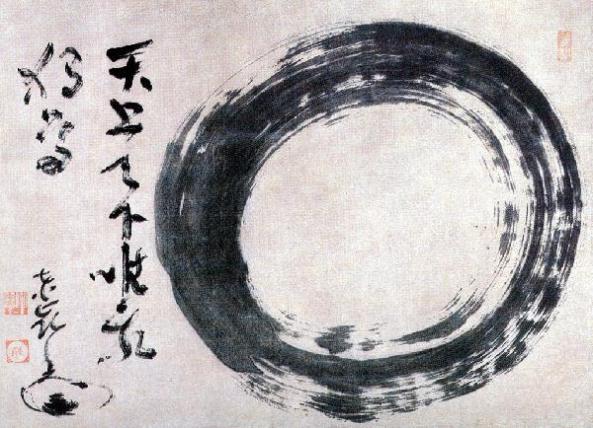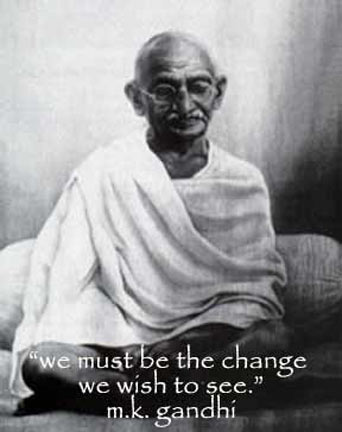"If you can empty the mind, be unhurried and loose, and completely lose the world, then you are one who trusts to things and follows the times." - Bodhidharma, Record I: the Method for Quieting Mind, The Bodhidharma Anthology: The earliest records of zen, (Jeffrey L. Broughton, 1999), p30.
"Thirty spokes converge on a hub, but it's the emptiness that makes a wheel work, pots are fashioned from clay, but it's the hollow that make a pot work, windows and doors are carved for a house, but it's the spaces that make a house work, existence makes something useful, but nonexistence makes it work." - Daoist Sage LaoZi (~5th Century BC), DaoDeJing.
"You should not lose your self‑sufficient state of mind. This does not mean a closed mind, but actually an empty mind and a ready mind. If your mind is empty, it is always ready for anything; it is open to everything." - Japanese Soto Zen teacher Shunryu Suzuki, Zen Mind, Beginner's Mind (1995), p21
"Empty this boat, monk! Empty it will travel quickly. Having cut off passion and hatred, you will approach the Nirvana." - The Buddha, Dhammapada, Verse 369.
"Midnight. No waves,no wind, the empty boat
is flooded with moonlight."
- Japanese 'Soto Zen' Founder Master Eihei Dogen, in Mindfulness teacher Dr. Jon Kabat-Zinn's book Wherever You Go, There You Are (2004), p232.

In his book Full Catastrophe Living (2005), the founder of Mindfulness-Based Stress Reduction (MBSR), Dr. Jon Kabat-Zinn, states the following, p263:
"Nowadays it is fashionable to use the word burnout to describe a... state of near or total psychological exhaustion with an accompanying loss of drive and enthusiasm for the details of your life. What used to give you pleasure no longer does. The person experiencing burnout feels alienated from work, family, and friends; nothing seems meaningful anymore."This burnout can easily occur in our modern busy lives, as we take on more than we can healthily handle - often filling our time with distractions so that we do not have to notice or think about the problems we are creating for ourselves. As Kabat-Zinn writes in Full Catastrophe Living, p258:
"Instead of facing up to your problems, you can run around like crazy doing good things until your life is overflowing with commitments and obligations and you can't possibly make time for yourself."This overflow of commitments means that we leave little, if any, space for new healthier activities, and we are less available to any new important matters.
When we reach burnout, we are like a boat that has filled with water - we become useless to ourselves and everyone around us. Even though we may have noble intentions as we sit in our metaphorical boats of our lives, we can be so frantically busy trying to put everything in order - bail out the water filling up the vessel - that we can cause the boat to rock all over the place and take in more water than can be bailed - until it eventually sinks.
Not only do we burn out, we also tend to beat ourselves up for burning out. In these situations; just like at any time when we fail - we can tell ourselves over and over again how useless we are. In The Mindful Way Through Depression (2007), Kabat-Zinn says the following of this self-abuse, p24:
"Imagine what effect it would have on you if someone stood behind you all day telling you how useless you were when you were trying desperately to cope with a difficult experience. Now imagine how much worse it would be if the criticism and harsh judgment came from inside your own mind. No wonder it seems so real - after all, who knows us better than ourselves ? These thoughts can trap us, turning a small sadness into a tangled web of brooding preoccupation."In order to deal with the over-subscription which leads to burnout, and the uselessness one can feel when one fails to meet one's responsibilities, mindfulness teachers have referred to the pursuit of 'emptying oneself' and witnessing the 'emptiness of one's existence' in order that one need not run away from the truth of our human condition, or react emotionally to negative thoughts.
One of the most famous classic zen stories regarding emptying the mind is portrayed in the book Zen Flesh, Zen Bones (1998) by Paul Reps and Nyogen Senzaki, and goes as follows, p19:
"Nan-in, a Japanese master during the Meiji era (1868-1912), received a university professor who came to inquire about Zen. Nan-in served tea. He poured his visitor's cup full, and then kept on pouring. The professor watched the overflow until he no longer could restrain himself. "It is overfull. No more will go in!". "Like this cup," Nan-in said, "you are full of your own opinions and speculations. How can I show you Zen unless you first empty your cup?"If we do not open and empty our minds we have very little space to take on new knowledge - especially when that knowledge is not something which can be passed on through words - knowledge which, like how to balance on one leg, requires direct experience beyond conceptual manipulation.
In order to open ourselves to experiencing a new perspective beyond conceptual description or manipulation, Japanese Soto Zen teacher Shunryu Suzuki says in his book, Zen Mind, Beginner's Mind (1995), that we need to maintain the attitude of a beginner - to never settle on some conceptual grasp of what is true - to be empty of the dualistic thoughts of right and wrong, p13-14:
"The mind of the beginner is empty, free of the habits of the expert, ready to accept, to doubt, and open to all the possibilities. It is the kind of mind which can see things as they are, which step by step and in a flash can realize the original nature of everything."

This emptiness of the beginner's mind allows one to be available to the experience of something new and helpful - something beyond the habitual labels one has imposed on one's experience; labels which have very possibly trapped one in the past. Suzuki says, in Zen Mind, Beginner's Mind, that emptying the mind in this way brings a new freedom and a power to concentrate more deeply, p112:
"before you put something in your room, it is necessary for you to take out something. If you do not, your room will become crowded with old, useless junk. We say, "Step by step I stop the sound of the murmuring brook." When you walk along the brook you will hear the water running. The sound is continuous, but you must be able to stop it if you want to stop it. This is freedom; this is renunciation. One after another you will have various thoughts in your mind, but if you want to stop your thinking you can. So when you are able to stop the sound of the murmuring brook, you will appreciate the feeling of your work. But as long as you have some fixed idea or are caught by some habitual way of doing things, you cannot appreciate things in their true sense. [...] Without this freedom you cannot be concentrated on what you do. You may think you are concentrated on something, but before you obtain this freedom, you will have some uneasiness in what you are doing. Because you are bound by some idea..., your activity is in dichotomy or duality. As long as you are caught by duality you cannot attain absolute freedom, and you cannot concentrate."Suzuki later states that the best way to experience an empty mind is through seated meditation (zazen), p128-129:
"...to have a firm conviction in the original emptiness of your mind is the most important thing in your practice. In Buddhist scriptures we sometimes use vast analogies in an attempt to describe empty mind. [...] But it is when you sit in zazen that you will have the most pure, genuine experience of the empty state of mind. Actually, emptiness of mind is not even a state of mind, but the original essence of mind which Buddha and the Sixth Patriarch experienced. "Essence of mind," "original mind," "original face," "Buddha nature," "emptiness"—all these words mean the absolute calmness of our mind. "

When the thoughts clutter the mind during seated meditation, however, this is normal. On this, Suzuki is quoted as saying, in Crooked Cucumber: The Life and Zen Teaching of Shunryu Suzuki (1999), that it is important not to engage the thoughts - in the sense of just allowing them to pass through one's dwelling space without interaction, p317:
In time, the mind clears and becomes empty of its own accord. Kabat-Zinn supports this need for acceptance and detachment in his book Wherever You Go, There You Are (2004), when he writes, p110:"In [meditation] leave your front door and back door open. Let thoughts come and go. Just don't serve them tea."
"...when we practice sitting meditation, first and foremost it means sitting in such a way that your body affirms, radiates, broadcasts an attitude of presence, that you are committed to acknowledging and accepting whatever comes up in any moment. This orientation is one of non-attachment and unwavering stability, like a clear mirror, only reflecting, itself empty, receptive, open. This attitude is contained in the posture, in the very way you choose to sit. The posture embodies the attitude."Taking this approach from seated meditation to all activities in life, we can empty ourselves sufficiently that we feel a deep freedom and relaxation - like we are on vacation. In Full Catastrophe Living, Kabat-Zinn talks of an encounter between Ghandi and a journalist which seems to illustrate this situation nicely, p361:
"Mahatma Gandhi was once asked by a journalist, "You have been working at least fifteen hours a day, every day for almost fifty years. Don't you think it's about time you took a vacation?" To which Gandhi replied, "I am always on vacation." Of course, the word vacation means "empty, vacant." When we practice being completely in the present, life in its fullness is totally accessible to us at all times, precisely because we are out of time. Time becomes empty and so do we. Then we, too, can always be on vacation."

Suzuki presents this practice in more formal terms when he says, in Zen Mind, Beginner's Mind, p86:
"We should always live in the dark empty sky. The sky is always the sky. Even though clouds and lightning come, the sky is not disturbed. Even if the flashing of enlightenment comes, our practice forgets all about it."When we become empty, we may directly witness something more profound about our existence in the world - that we have no discrete identity; no true boundary between ourselves and the universe. As Vietnamese Zen teacher Thich Nhat Hanh states in his book The Sun My Heart (1988), p89:
"To be empty is not to be nonexistent. It is to be devoid of a permanent identity."He elaborated further on this topic during a Dharma Talk at the University of Nottingham, United Kingdom, on August 17, 2010, with reference to the existence of a chrysanthemum flower:
"When we look into this beautiful chrysanthemum, we get the impression that this flower is full of the cosmos. Everything in the cosmos is there in the flower, including the cloud, the sunshine, the soil, minerals, time, and space, everything. It looks like the whole cosmos has come together to manifest the flower. The one contains the all.
There is only one thing that is not there: that is a separate entity, a separate existence. The flower is full of the cosmos, of everything else, but the flower is empty of a separate self. No separate self, that is the first meaning of emptiness. You cannot be by yourself. You have to inter-be with the cosmos. And we are all in you. If you look deeply into yourself, you see all of us in you. That is the beginning of the contemplation of interbeing, focusing on the teaching of emptiness."

American Zen teacher Charlotte Joko Beck, in her book Everyday Zen (1997), describes the experience of this inter-being as follows, p126:
Although these words are easy and beautiful to comprehend, just thinking about it will not bring much change. As Kabat-Zinn states in Full Catastrophe Living, discipline and lots of meditation practice is necessary, p150:"If we practice hard enough... we learn that not only is the observer empty, but that which is observed is also empty. At this point the observer (or witness) collapses. This is the final stage of practice; we don’t need to worry about it. Why does the observer finally collapse? When nothing sees nothing, what do we have? Just the wonder of life. There is no one who is separated from anything."
"...meditation practice itself, this kind of learning requires a lifelong commitment to continual inquiry and a willingness to modify your perspective as you acquire new knowledge and arrive at new levels of understanding and insight."One of the key tools Kabat-Zinn uses to achieve a state of emptiness during seated meditation is the body scan, as he writes in Full Catastrophe Living, p77:
"By the time we have completed the body scan, it can feel as if the entire body has dropped away or has become transparent, as if its substance were in some way erased. It can feel as if there is nothing but breath flowing freely across all the boundaries of the body. As we complete the body scan, we let ourselves dwell in silence and stillness, in an awareness that may have by this point gone beyond the body altogether."
The more this mode of existence appears, the more one can disengage from any negative thought patterns, and one can become more available to new challenges. The author of Mindfulness for Dummies (2010), says the following of this process, p234:
"The thought, ‘It’s all my fault; I’m completely useless,’ is just thought, not facts. When you begin to touch this inner wholeness... You become more optimistic in both the present moment and the future. From your more detached, free and lighthearted stance, your perception of your predicament shifts, and you allow more space for your body to heal as best it can..."
However, as is usual with zen practice, we must not seek conceptual goals such as being more empty or useful, lest we fill ourselves up with rigid, inflexible notions, and close our minds off once again. The practice, once begun, is just continued for it's own sake. Shunryu Suzuki mentions this in the book Branching
Streams Flow in the Darkness (1999), p165:
"When you do something with a purpose based on some evaluation of what is useful or useless, good or bad, more or less valuable, your understanding is not perfect. If you do things that need to be done regardless of whether the results are good or bad, successful or unsuccessful, that is real practice. If you do things not because of Buddha, or truth, or yourself, or others, but for the things themselves, that is the true way."The Sixth Patriarch of Zen, Huìnéng, spoke the following of pursuing emptiness, in The Platform Sutra of the Sixth Patriarch (John R. McRae, 2000), p28-29:
"Good friends, don’t listen to me explain emptiness and then become attached to emptiness. The most important thing is not to become attached to emptiness. If you empty your minds and sit in quietude, this is to become attached to the emptiness of blankness."
"The world calls me great, great but useless, because I am great I am useless, if I were of use I would have stayed small, but I possess three treasures, I treasure and uphold, first is compassion, second is austerity, third is reluctance to excel. because I am compassionate, I can be valiant, because I am austere, I can be extravagant, because I am reluctant to excel, I can be chief of all tools".



No comments:
Post a Comment